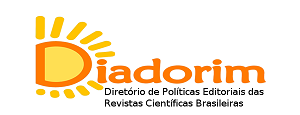AVALIAÇÃO ANTIMICROBIANA DO EXTRATO ETANÓLICO DA POLPA DE PEQUI (Caryocar coriaceum Wittm.) CONTRA MICRORGANISMOS PATOGÊNICOS
DOI:
https://doi.org/10.20873/rtg.v12i27.15734Palabras clave:
Caryocar coriaceum, Pequi, Saúde Bucal, Atividade antimicrobianaResumen
A resistência microbiana aos antimicrobianos tem sido uma ameaça crescente para o tratamento efetivo de uma gama cada vez maior de infecções causadas por bactérias e fungos; a sensibilidade reduzida de antibacterianos e antifúngicos, vem tornando o tratamento de muitos pacientes difícil. O Pequi, além da qualinária, é utilizado para fins terapêuticos como um anti-inflamatório e antimicrobiano no combate a infecções. No entanto, sabe-se pouco sobre os efeitos antimicrobianos da sua polpa e sobre a sua composição fitoquímica. O presente trabalho visou investigar, a ação antimicrobiana do extrato etanólico da polpa de C. coriaceum Wittm. frente a duas cepas bacterianas e uma fúngica de interesse à saúde bucal. O extrato do fruto de C. coriaceum foi obtido por extração empregando extrator Soxhlet e a atividade antimicrobiana foi avaliada pela técnica difusão em disco-ágar, sobre Enterococcus faecalis, Streptococcus pyogenes e Candida albicans. A levedura C. albicans foi inibida na concentração mais elevada, 25,2 mg.mL-1 de extrato, com a média dos halos ficando em 10 mm; para a bactéria E. faecalis foi verificada inibição leve nas concentrações de 25,2 e 2,52 mg.mL-1 com halos de 8 e 6 mm, respectivamente. Os resultados verificaram que o extrato etanólico da polpa C. coriaceum apresenta indicativo de atividade antifúngica e antibacteriana. Sugerem-se mais estudos quanto ao seu potencial efeito antimicrobiano.
Citas
ABACHI S, L. S.; RUPASINGHE, H.P. Molecular Mechanisms of Inhibition of Streptococcus Species by Phytochemicals. Molecules. v. 21, n. 2, p. 210-2015, 2016.
ALVES, A.M.; FERNANDES, D.C.; SOUSA, A.G, et al. Características físicas e nutricionais de pequis oriundos dos Estados de Tocantins, Goiás e Minas Gerais: Brazilian J. of Food Technology. v. 17, n. 3, p. 198-203, 2014.
ALVES, D.R.; MAIA, M.S.; TOMIOTTO-PELLISSIER, F, et al., Composição Flavonoide e Atividades Biológicas de Extratos Etanólicos de Caryocar coriaceum Wittm., Uma Planta Nativa do Bioma Caatinga: Evid Based Complement Alternat Med. Ano 4, n. 1, 2017.
ANAND, G.; RAVINANTHAN, M; BASAVIAH, R, et al., Efeitos antimicrobianos e citotóxicos in vitro de Anacardium occidentale e Mangifera indica na higiene bucal. J. Pharm Bioallied Sci. v. 7, n. 1., p. 69-74, 2015.
ANDRADE, E.D. Terapêutica medicamentosa em odontologia. 3. ed. São Paulo: Artes Médicas, 2014.
AQUINO, L.P.; FERRUA, F.Q.; BORGES, S.V. et al. Influência da secagem do pequi (Caryocar brasiliense Camb.) na qualidade do óleo extraído. Food Sci. Technol. v. 29, n. 2, p. 354-357, 2009.
ASSIS RC, LIMA GSR, SIQUEIRA ACP, et al. Determination of water-soluble vitamins and carotenoids in Brazilian tropical fruits by High Performance Liquid Chromatography. Heliyon. v. 28, n. 6, p. 53-67, 2020.
AVILA, M.; OJCIUS, D.M.; YILMAZ, O. The oral microbiota: living with a permanent guest. DNA Cell Biol. V. 28, n. 8, p. 405-411, 2009.
BAPTISTA, A.; GONÇALVES, R.V.; BRESSAN, J. et al. Antioxidant and Antimicrobial Activities of Crude Extracts and Fractions of Cashew (Anacardium occidentale L.), Cajui (Anacardium microcarpum), and Pequi (Caryocar brasiliense C.): A Systematic Review. Oxid Med Cell Longev. v. 2018, n. 2, p. 01-13, 2018.
BLANC V.; ISABAL, S.; SANCHEZ, M.C, et al. Characterization and application of a flow system for in vitro multi species oral biofilm formation. J Periodontal Res v.49, n.2, p. 323-332, 2014.
CARDOZO, C.M.L.; INADA, A.C.; MARCELINO, G. et al. Therapeutic Potential of Brazilian Cerrado Campomanesia Species on Metabolic Dysfunctions. Molec. v.23, n.9, p. 23-36, 2018.
CHISTÉ, R.C.; MERCADANTE, A.Z. “Identificação e quantificação, por HPLC-DAD-MS / MS, de carotenóides e compostos fenólicos da fruta amazônica Caryocar villosum”. J. of Agricul and Food Chem. v. 60, n.3, p. 84-92, 2012.
COSTA, G.M.J.; BRITO, S.A.; NASCIMENTO, E.M.M. et al. Antibacterial Properties of Pequi Pulp Oil (Caryocar coriaceum – Wittm.), Inl J. of Food Prop. v. 14, n. 2, p. 39-52, 2011.
GBD (Global Burden of Disease), 2017, Disease and Injury Incidence and Prevalence Collaborators. et al. Lancet; v. 392, n. 10159, p. 1789-1788, 2018.
GOMES, A.B.; RIBEIRO, I.A. Evaluation of antifungal potential of oil of the species Caryocar coriaceum front of candida species isolated in the oral cavity of oncological pediatric patients in antineoplastic treatment. Int J. of Ped Res and Rev, v. 2, n. 11, p.1-9, 2019.
GONÇALVES, A.P.P.; VIEIRA, G.D.; CUNHA, P.N.A. et al. Caracterização fitoquímica e atividade antimicrobiana de extratos de Solanum subinerme (Solanaceae) Rev. Bras. Pesq. Saúde, v. 18, n. 2, p. 8-16, 2016.
KANE, S,F. The effects of oral health on systemic health. Gen Dent. v. 65, n. 6, p. 30-34, 2017.
KANTH, M.R.; PRAKASH, A.R.; SREENATH, G. et al. Efficacy of Specific Plant Products on Microrganisms Causing Dental Caries. J Clin Diagn Res. v. 10, n. 12, p.1-3, 2016.
KRAMER PF, FELDENS CA, FERREIRA, S.H. et al. Exploring the impact of oral diseases and disorders on quality of life of preschool children. Comm Dent Oral Epidemiol. v. 41, n. 4, p.327-335, 2013.
MADIANOS PN, BOBETSIS YA, KINANE DF. Generation of inflammatory stimuli: how bacteria set up inflammatory responses in the gingiva. J Clin Periodontol. v. 32, suppl. 6, p. 57-71, 2005.
MARSH, P.; MARTIN, R. Microbiologia oral. 6. ed. Rio de Janeiro: Elsevier, 2018.
OLIVEIRA, C.; PINTO, E.; REZENDE, P. Compostos bioativos de extratos de pequi de diferentes regiões do cerrado. Encicl. Bio, v. 14, n. 25 p. 1799-1813, 2017.
PAULA-JUNIOR, W.; ROCHA, F.H.; DONATTI, L. et al. Leishmanicidal, antibacterial, and antioxidant active.ities of Caryocar brasiliense Cambess leaves hydroethanolic extract. Rev. Bras. Farmacogn. v. 16, suppl. 16, p. 625-630, 2006.
PAULO, C.R.; PEREIRA, F.F.; MACHADO, M.S. et al. Composição química e atividade antibacteriana do óleo fixo da amêndoa de Caryocar coriaceum, In:
REUNIÃO REGIONAL DA SBPC NO CARIRI, LXIX, 2017, Cariri, CE. Anais…Cariri. 4.03.02 – Farmácia / Farmacognosia.
RIBEIRO, D.M. Propriedades físicas, químicas e bioquímicas de Pequi (Caryocar brasiliense Camb.) de diferentes regiões do Cerrado. Dissertação (Mestrado) – Universidade de Brasília, UnB, Brasília. 2011.
ROCHA, L.B.; MELO, A.M.; PAULA, S.L. et al. Gallic acid as the major antioxidant in pequi (Caryocar brasiliense Camb.) fruit peel. Rev. Bras. Plantas Med. v. 17, n. 4, p. 592-509, 2015.
RODRIGUES, M.A.; CARDOSO, F.M.; RACHEL, M.N. et al. Perfil fitoquímico e quantificação de compostos bioativos nos extratos da folha da Caryocar Coriaceum. SIMPÓSIO LATINO – AMERICANO DE QUÍMICA & V WORKSHOP DE BIOTECNOLOGIA DA REDE BIONORTE, Anais…Simposio Latinoamericano de Química: “Los desafíos de la investigación en América Latina" even 3 editor, 2021.
SARAIVA, R.A.; LEMOS, I.C.S.; FIGUEIREDO, P.R.L. Caryocar coriaceum W. In: Biological Chemistry, Regional University of Cariri, Crato, Ceará, Brazil. Springer Nature B.V. Medical and aromatic Plants of South América, Medicinal and Aromatic Plants of the Word 5. p. 153-162, 2018.
.
SARQUIS, F.R.; SOCORRO, R. do; RODRIGUES, S.I. et al. The Use of Medicinal Plants in the Riverside Community of the Mazagão River in the Brazilian Amazon, Amapá, Brazil: Ethnobotanical and Ethnopharmacological Studies. Evid Based Compt Alter Med. v. 19, n. 4, p. 1-25, 2019.
TOMIOTTO-PELLISSIER, F.; ALVES, D.R.; MIRANDA-SAPLA, M.M. et al. Caryocar coriaceum extracts exert leishmanicidal effect acting in promastigote forms by apoptosis-like mechanism and intracellular amastigotes by Nrf2/HO-1/ferritin dependent response and iron depletion: Leishmanicidal effect of Caryocar coriaceum leaf exracts. Bio Pharma. . v. 8, n. 2, p. 62-72, 2018.
Descargas
Publicado
Cómo citar
Número
Sección
Licencia
Derechos de autor 2023 Revista Tocantinense de Geografía

Esta obra está bajo una licencia internacional Creative Commons Atribución-NoComercial-SinDerivadas 4.0.
Revista Tocantinense de Geografia no remunera a ningún autor por la publicación de sus textos. Los contenidos de los textos publicados en esta revista son responsabilidad de los autores.








.png)












